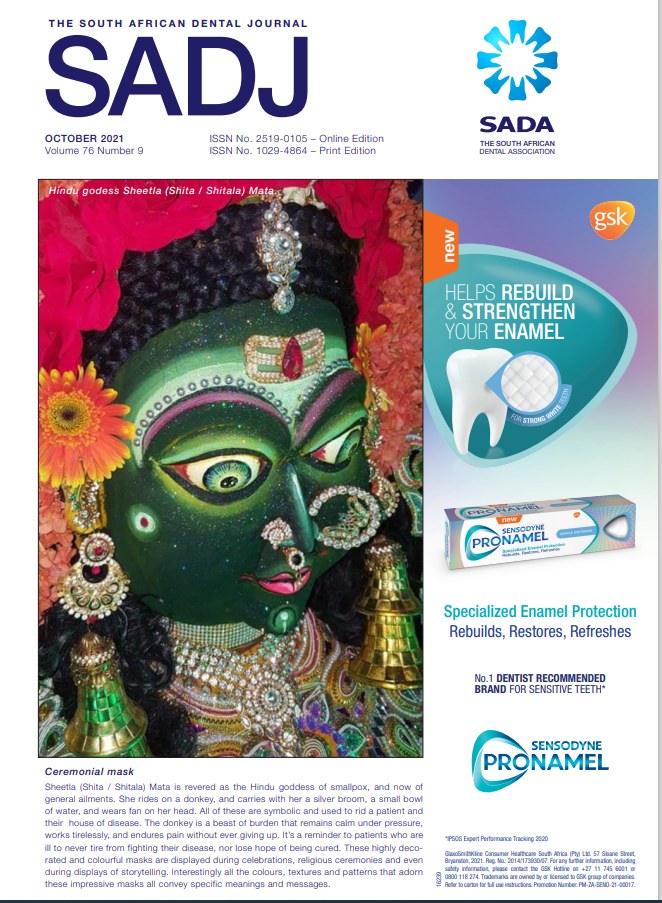Resolution of a large periapical lesion in an immature maxillary lateral incisor with the aid of triple antibiotic paste
DOI:
https://doi.org/10.17159/2519-0105/2021/v76no9a7Keywords:
apexification, endodontics, triple antibiotic paste, calcium hydroxideAbstract
Apexification procedures are frequently performed on immature permanent teeth with incomplete root formation, open apices and necrotic pulp status with or without periapical lesions in order to induce a calcific barrier prior to root canal therapy. The elimination and control of infection in the root canal space is critical to the success of these procedures. A healthy 21-year old male presented with pulpal necrosis, a large periapical lesion, incomplete root formation and an open apex on a maxillary right lateral incisor. Triple antibiotic paste was used to achieve antimicrobial control after traditional calcium hydroxide paste medicament failed to resolve
the symptoms. Obturation was achieved using MTA and the conventional apexification technique. Excellent healing of the large periapical lesion was achieved without surgical intervention and the 4-year follow-up CBCT demonstrated complete bone fill of the lesion. Clinicians should be aware that alternative antimicrobial medicaments, such as triple antibiotic paste, may be
beneficial in situations where conventional medicaments prove unsuccessful. The use of triple antibiotic paste may result in sufficient healing of the periapical lesion to justify placement of an MTA apical barrier without the need for surgical intervention
Downloads
References
Shabahang S. Treatment options: Apexogenesis and apexification. Pediatr Dent. 2013; 35: 125–8. DOI: https://doi.org/10.1016/j.joen.2012.11.046
Sheely E, Roberts G. Use of calcium hydroxide for apical barrier formation and healing in non-vital immature permanent teeth: a review. Br Dent J. 1997; 183: 241–6. DOI: https://doi.org/10.1038/sj.bdj.4809477
Andreasen J, Farik B, Munksgaard E. Long-term calcium hydroxide as a root canal dressing may increase risk of root fracture. Dent Traumatol. 2002; 18: 134–7. DOI: https://doi.org/10.1034/j.1600-9657.2002.00097.x
Parirokh M, Torabinejad M. Mineral Trioxide Aggregate: A Comprehensive Literature Review-Part III: Clinical Applications, Drawbacks, and Mechanism of Action. J Endod. 2010; 36: 400–13. DOI: https://doi.org/10.1016/j.joen.2009.09.009
Modena K, Casas-Apayco L, Atta M, Costa C, Hebling J, Sipert C, et al. Cytotoxicity and biocompatibility of direct and indirect pulp capping materials. J Appl Oral Sci. 2009; 17: 544–54. DOI: https://doi.org/10.1590/S1678-77572009000600002
Bajwa N, Jingarwar M, Pathak A. Single Visit Apexification Procedure of a Traumatically Injured Tooth with a Novel Bioinductive Material (Biodentine). Int J Clin Pediatr Dent. 2015; 8: 58–61. DOI: https://doi.org/10.5005/jp-journals-10005-1284
Sato I, Kota K, Iwaku M, Hoshino E. Sterilization of infected root-canal dentine by topical application of a mixture of ciprofloxacin, metronidazole and minocycline in situ. Int Endod J. 1996; 29: 118–24. DOI: https://doi.org/10.1111/j.1365-2591.1996.tb01172.x
Trope M. Regenerative potential of dental pulp. Pediatr Dent. 2008; 30: 206–10. DOI: https://doi.org/10.1016/j.joen.2008.04.001
Huang G. A paradigm shift in endodontic management of immature teeth: Conservation of stem cells for regeneration. J Dent. 2008; 36: 379–86. DOI: https://doi.org/10.1016/j.jdent.2008.03.002
Cvek M. Prognosis of luxated non-vital maxillary incisors treated with calcium hydroxide and filled with gutapercha. Dent Traumatol. 1992; 8: 45–55. DOI: https://doi.org/10.1111/j.1600-9657.1992.tb00228.x
Kim S, Malek M, Sigurdsson A, Lin L, Kahler B. Regenerative endodontics: a comprehensive review. Int Figure 5. Cvek’s classification of root development10www.sada.co.za / SADJ Vol. 76 No. 9Endod J. 2018; 51: 1367–88. DOI: https://doi.org/10.1111/iej.12954
Kontakiotis E, Filippatos C, Agrafioti A. Levels of evidence for the outcome of regenerative endodontic therapy. J Endod. 2014; 40: 1045–53. DOI: https://doi.org/10.1016/j.joen.2014.03.013
Soares J, Santos S, Silveira F, Nunes E. Nonsurgical treatment of extensive cyst-like periapical lesion of endodontic origin. Int Endod J. 2006; 39: 566–75. DOI: https://doi.org/10.1111/j.1365-2591.2006.01109.x
Hoshino E, Kurihara-Ando N, Sato I, Uematsu H, Sato M, Kota K, et al. In-vitro antibacterial susceptibility of bacteria taken from infected root dentine to a mixture of ciprofloxacin, metronidazole and minocycline. Int Endod J. 1996; 29: 125–30. DOI: https://doi.org/10.1111/j.1365-2591.1996.tb01173.x
Madhubala M, Srinivasan N, Ahamed S. Comparative Evaluation of Propolis and Triantibiotic Mixture as an Intracanal Medicament against Enterococcus faecalis. J Endod. 2011; 37: 1287–9. DOI: https://doi.org/10.1016/j.joen.2011.05.028
Er K, Kuştarci A, Özan Ü, Taşdemir T. Nonsurgical Endodontic Treatment of Dens Invaginatus in a Mandibular Premolar with Large Periradicular Lesion: A Case Report. J Endod. 2007; 33: 322–4. DOI: https://doi.org/10.1016/j.joen.2006.09.001
Kusgoz A, Yildirim T, Er K, Arslan I. Retreatment of a Resected Tooth Associated with a Large Periradicular Lesion by Using a Triple Antibiotic Paste and Mineral Trioxide Aggregate: A Case Report with a Thirty-month Follow-up. J Endod. 2009; 35: 1603–6. DOI: https://doi.org/10.1016/j.joen.2009.07.019
Vidal K, Martin G, Lozano O, Salas M, Trigueros J, Aguilar G. Apical Closure in Apexification: A Review and Case Report of Apexification Treatment of an Immature Permanent Tooth with Biodentine. J Endod. 2016; 42: 730–4. DOI: https://doi.org/10.1016/j.joen.2016.02.007
Rosenberg P, Frisbie J, Lee J, Lee K, Frommer H, Kottal S, et al. Evaluation of Pathologists (Histopathology) and Radiologists (Cone Beam Computed Tomography) Differentiating Radicular Cysts from Granulomas. J Endod. 2010; 36: 423–8. DOI: https://doi.org/10.1016/j.joen.2009.11.005
Simon J, Enciso R, Malfaz J, Roges R, Bailey-Perry M, Patel A. Differential Diagnosis of Large Periapical Lesions Using Cone-Beam Computed Tomography Measurements and Biopsy. J Endod. 2006; 32: 833–7. DOI: https://doi.org/10.1016/j.joen.2006.03.008
Sharma S, Sharma V, Passi D, Srivastava D, Grover S, Dutta S. Large Periapical or Cystic Lesions in Association with Roots Having Open Apices Managed Nonsurgically Using 1-step Apexification Based on Platelet-rich Fibrin Matrix and Biodentine Apical Barrier: A
Case Series. J Endod. 2018; 44: 179–85.
Downloads
Published
Issue
Section
License

This work is licensed under a Creative Commons Attribution-NonCommercial 4.0 International License.






.png)